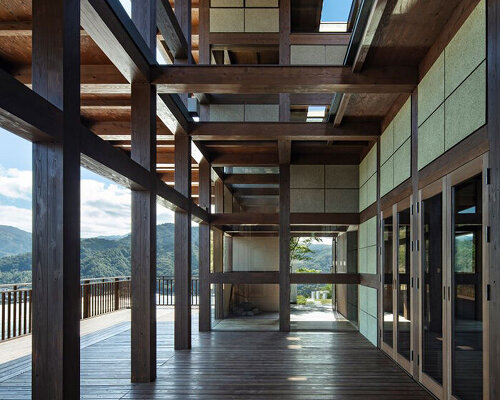aki hamada designs symbol of mt. oboshi
Aki Hamada Architects (AHA) completes a new headquarters in Fujikawa Town, Yamanashi Prefecture, designed as a contemporary architectural symbol of the nearby Mt. Oboshi. The building is perched on terraced land overlooking the Fuji River and Mt. Fuji beyond. For the client, whose business centers on recycling, the location is personally significant. Rather than leveling the terrain, the project draws from the Kake-zukuri style of traditional architecture, adapting a strategy of timber-based construction that steps with the landscape.
This sensibility extends into a voxel-based structural system developed specifically for the project. Replacing the nuki joinery typical of post-and-beam construction, AHA uses modern metal jointing to construct a three-dimensional lattice of bundled timber beams and columns. The voxel system is inspired by computational modeling units which allows flexibility for future expansion.
images © Kenta Hasegawa
Structural Abstraction with Traditional References
The team at Aki Hamada Architects applies a three-dimensional grid to the site’s shifting elevation, extending the concept of Kake-zukuri across foundation and superstructure. At this scale, four 120 millimeter-square timbers are grouped to form bundled columns and beams, with the number of members adaptable to different spans and load demands. Precutting techniques allowed for precise finishing and connection detailing, minimizing complexity during onsite assembly and drawing from the logic of reinforced concrete detailing seen in postwar Japanese buildings.
The modularity also integrates practical features directly into the structure. Wall panels, equipment, and window frames — often treated as separate construction elements — are embedded within the timber framework. The resulting structure takes on a design language that is at once rational and expressive. It celebrates the material logic of timber and borrows from the visual rhythm of modernism.
the headquarters by Aki Hamada Architects is located in Fujikawa Town near Mt Oboshi
A Voxel System with Earthen Tactility
The Mt. Oboshi workspace’s structure is designed by Aki Hamada Architects with panels made by from a mixture of soil and locally-sourced grass. These walls slot into the lattice like structural infill, reinforcing the building’s connection to place. Along the western facade, fixed windows optimize daylight, while deep cantilevered eaves frame views across the valley toward Mt. Fuji.
The ground floor opens into a terrace and corridor structure under the lattice canopy. With lofty ceilings and deep eaves, the covered area serves as a contemporary engawa — a semi-outdoor buffer zone between inside and out. This porticoed space welcomes visitors in all weather and mediates the transition between the landscape and the workspace beyond.
at night, the wooden frame glows softly. a light tower beside the building enhances the silhouette
Inside, the spatial experience is shaped by the repeated rhythm of the timber grid. Structural axes layer across each other, producing varying degrees of enclosure, openness, and depth. The first floor accommodates both staff and visitors, supported by an open layout with a lobby and kitchen counter that encourage informal gathering.
Circulation between levels is anchored by an elliptical spiral staircase. Framed in steel, its form was dimensioned to fit both delivery requirements and the building’s floor plan. Suspended within the lattice, it creates the visual impression that the heavy timber frame is floating as a hybrid effect only possible through the combined logic of steel and wood.
a deep portico space welcomes visitors under a canopy of cantilevered eaves
the design references traditional Kake-zukuri architecture to build with the terrain
a steel elliptical staircase gives the heavy timber structure a sense of levitation
precut timber and metal joints enable abstract framing with efficient onsite assembly
overlapping structural axes frame views of Mt. Fuji and the surrounding valley
project info:
name: Voxel Lattice in Mt. Oboshi
architect: Aki Hamada Architects (AHA) | @aki_hamada_architects
location: Fujikawa Town, Yamanashi Prefecture
lead architects: Aki Hamada, Yuki Sazuka
completion: 2024
photography: © Kenta Hasegawa | @kentahasegawa
construction: Suiga
structure: Enshu Structural Consultants
lighting: ENDO Lighting Corp.
light art: Non-Classic
The post aki hamada architects-designed workspace frames mt. oboshi with timber voxel grid appeared first on designboom | architecture & design magazine.

